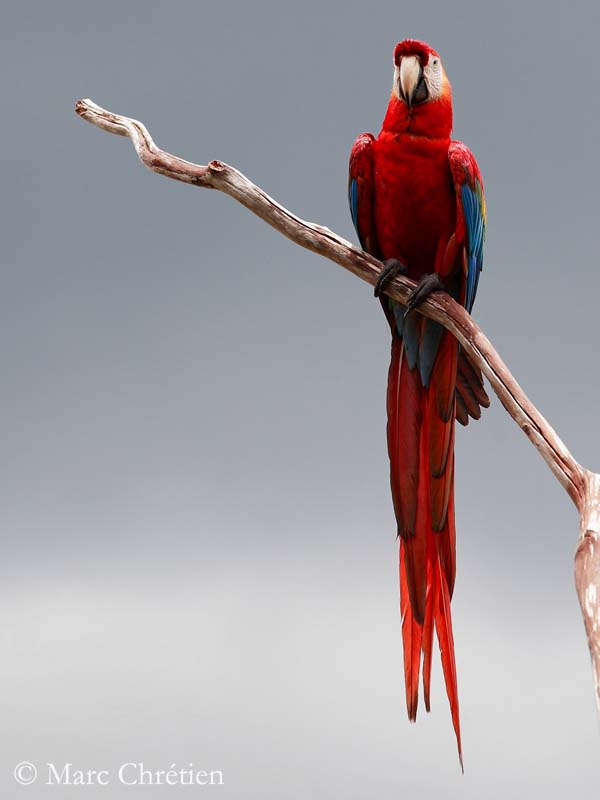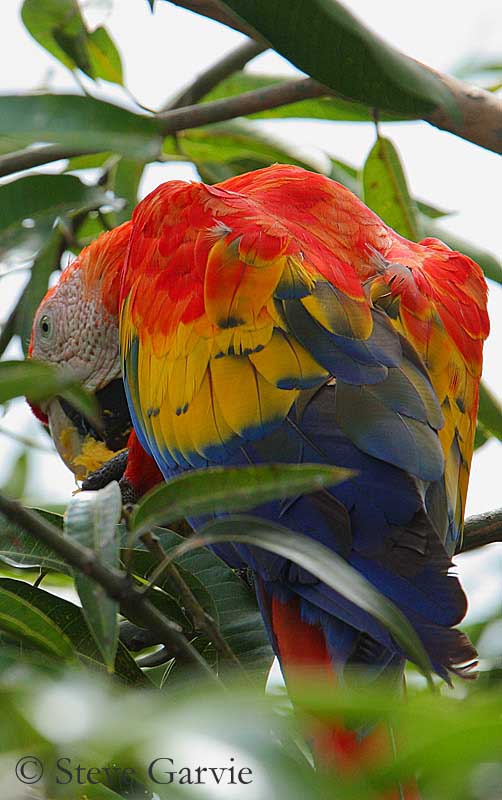
Scarlet Macaw
Ara macao
Psittaciforme Order - Psittacidae Family
BIOMETRICS :
Length: 84-89 cm ; Weight: 900-1490 g
LONGEVITY : 40 to 50 years in wild, and about 80 in captivity
DESCRIPTION:
Scarlet Macaw is the Honduran national bird. Very popular cage bird, this species suffers great trapping pressure and it is threatened by habitat destruction.
Adult has mainly red plumage, except on wings, rump and tail. Rump is pale blue. On upperwing, greater and median coverts are yellow with green edges. Flight feathers are blue.
Uppertail coverts are blue, and graduated tail is red, with blue-tipped feathers.
On the underparts, Scarlet Macaw has red plumage. Underwing and undertail feathers are mainly darker red, with gold iridescence. Undertail coverts are blue.
Head is red. We can see indistinct feathered lines on the white bare face, from base of the bill, through cheeks and around the eyes, to ear coverts.
Strong, hooked bill is black, except the upper mandible which is pale grey to horn-coloured. Eyes are pale yellow. Legs and feet are dark grey to blackish. Feet are zygodactylous, with 2 toes forwards, and 2 backwards.
Both sexes are similar.
Juvenile has shorter tail than adults, and dark eyes. It reaches its sexual maturity at 3 or 4 years.

We find two subspecies. They differ in distribution and wing plumages show different colours.
Ara macao macao, lives in Brazil
Ara macao cyanoptera is found in Central America.
VOICE: SOUNDS BY XENO-CANTO
Scarlet Macaw utters loud “rraa-aaarr” or “kurr-rraak”. It also gives harsh, low-pitched squawks, or screams. It can utter prolonged growling “kree-eeet”, and sometimes softer squeaks.
HABITAT:
Scarlet Macaw frequents wide variety of wooded lands, deciduous forests and open woodlands, edges of pine forests, to lowland forests and wooded galleries along watercourses, pastures or cultivated areas, with some forest patches. It can be found from 500 to 1000 metres of elevation.
RANGE:
Scarlet Macaw lives in Central America and northern South America, to Amazonian Peru and Brazil.
BEHAVIOUR:
Scarlet Macaw is mainly resident in its range. It can perform seasonal movements according to food resources.
This species is noisy and conspicuous. Usually seen in pairs, it also can be found in family groups or in small flocks of up to 20 birds. Larger flocks can be attracted by abundant food sources.
Scarlet Macaws roost at communal roost in trees. Flocks are very noisy when arriving or leaving roost-sites for feeding areas, performing spectacular flights. This bird is shy and wary, taking off while calling if disturbed. Scarlet macaw is an arboreal species. It feeds and rests in canopy of tall trees. They have very large territories, and nest in holes in tall trees.
Scarlet macaw feeds on seeds, nuts, fruits, leaves, bark, nectar and flowers. Central American birds eat seeds from pines, by crushing the cones and dropping numerous scales in order to extract the seeds. Scarlet Macaw is also seen eating clay from river bank, probably to digest poisonous chemicals found in unripe fruits.
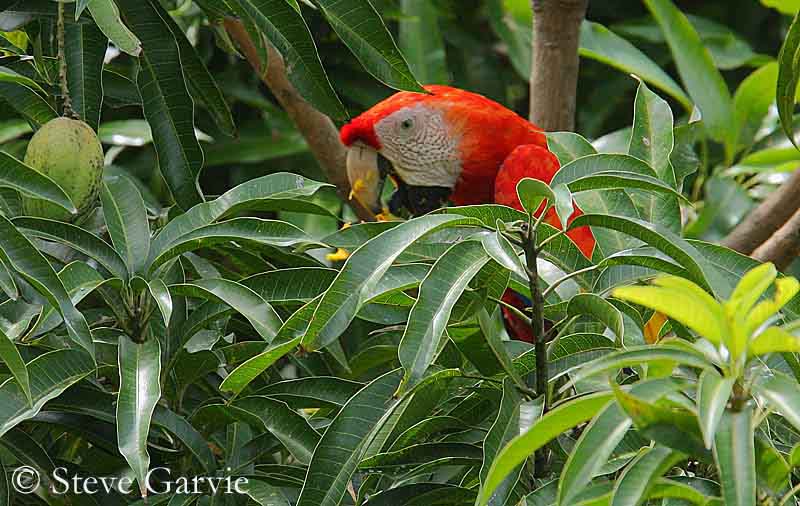
Scarlet macaws are monogamous and mate for life. Mates perform mutual preening, and they lick each other’s faces.
FLIGHT:
Scarlet Macaw performs direct flight, with steady and shallow wing beats. Both birds of a pair often fly close to each other, with wing tips almost touching. Its wide, strong wings allow speeds of 55 km per hour. They maintain contact in flight by raucous calls.
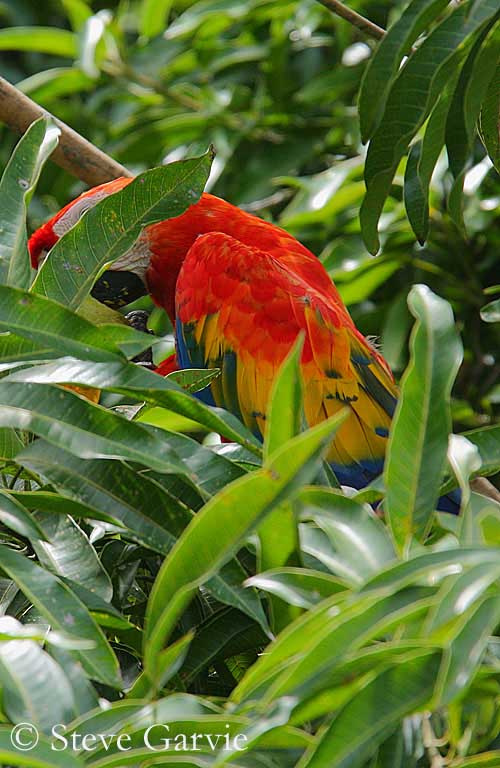
REPRODUCTION:
Breeding season varies, according to the location.
Scarlet Macaws mate for life. They nest in large cavity, a hollow in tall tree, between 7 to 40 metres above the ground, in the upper canopy of rainforest, among dense foliage.
Female lays 2 to 4 white eggs. Incubation lasts about 24 to 28 days, mainly by female.
Young are fed by both parents, by regurgitated food. They remain at nest about 14 weeks, and after fledging, they stay with parents for one or two years more.
This species produces one brood every two years.
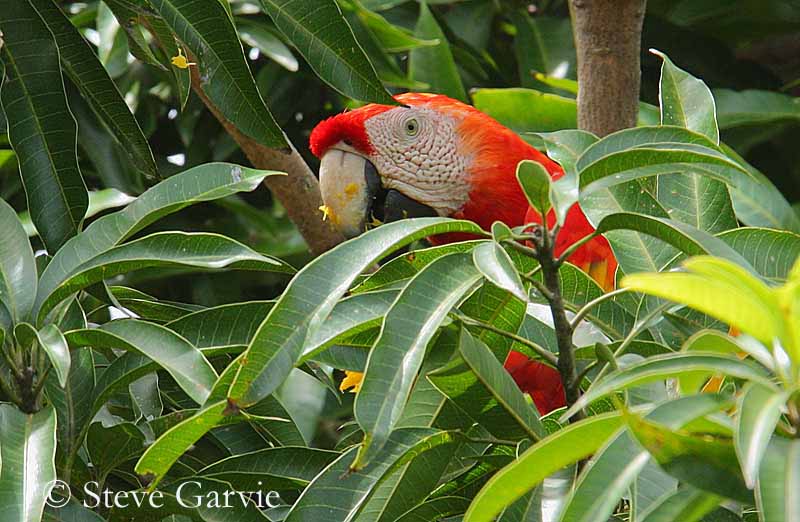
DIET:
Scarlet Macaw feeds mainly on fruits and nuts, and can add sometimes nectar and flowers. It consumes unripe fruits. It is able to break open hard nuts with its powerful beak. It presses the nut between its tongue and palate, in order to grind the seed.
PROTECTION / THREATS / STATUS:
Scarlet Macaw is threatened by habitat loss, with destruction of habitat in rainforest. Trapping for illegal trade is also an important threat for these macaws.
Nest boxes are provided to help these macaws for breeding, when natural nest-sites are not available.
Fr: Ara rouge
All: Arakanga
Esp: Guacamayo Macao
Ital: Ara rossa e gialla
Nd: Geelvleugelara
Russe: Красный ара
Sd: Ljusröd ara
Photographs by Steve Garvie
His website : RAINBIRDER Photo galleries
Photograph of the perched macaw by Marc Chrétien
Son site :MURINUS
Text by Nicole Bouglouan
Sources :
HANDBOOK OF THE BIRDS OF THE WORLD vol 4 by Josep del Hoyo-Andrew Elliott-Jordi Sargatal - Lynx Edicions - ISBN: 8487334229
PARROTS OF THE WORLD – An Identification Guide – by Joseph M. Forshaw – Princeton University Press – ISBN 0691092516
A GUIDE TO THE BIRDS OF COLOMBIA by Steven L. Hilty and William L. Brown
Princeton University Press – ISBN 069108372X
Wikipedia (Wikipedia, The Free Encyclopedia)
Animal Diversity Web (University of Michigan Museum of Zoology)
